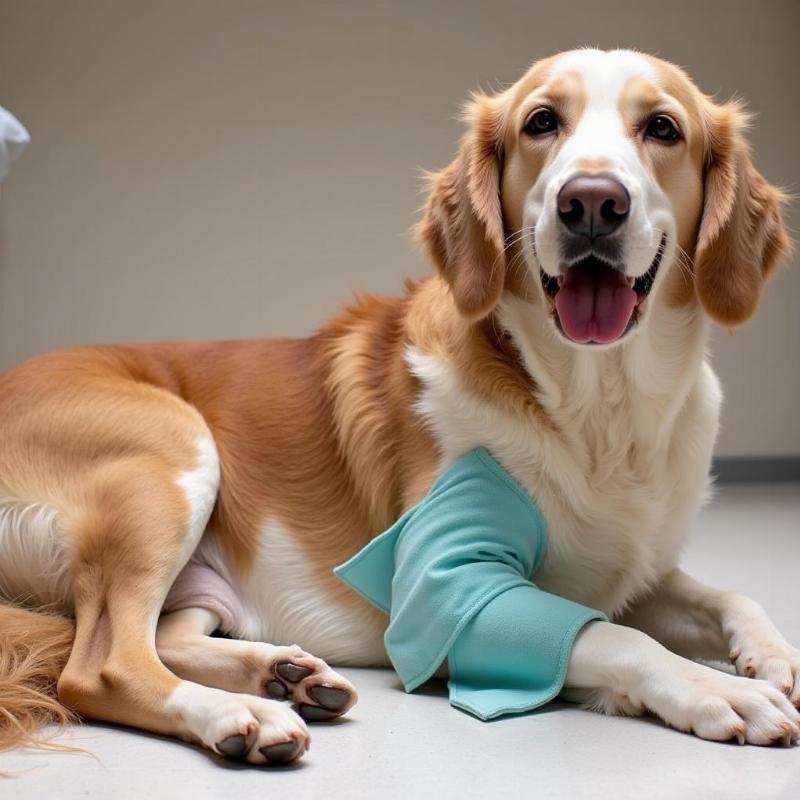The modified Robert Jones bandage is a common technique used in veterinary medicine to provide temporary support and immobilization to an injured limb in dogs. It’s often applied after surgery or trauma, helping to reduce swelling, stabilize fractures, and protect wounds. Understanding how this bandage works and when it’s appropriate is crucial for any dog owner. This guide provides a detailed look at the modified Robert Jones bandage, including its purpose, application, and aftercare.
Understanding the Modified Robert Jones Bandage
The modified Robert Jones bandage is a bulky, compressive bandage designed to provide support and immobilization to a dog’s injured limb. Unlike the original Robert Jones bandage, which uses much more padding, the modified version uses less, making it less cumbersome and more practical for at-home care. However, it still provides adequate support and compression to help reduce swelling, pain, and further injury. This bandage is particularly beneficial for injuries below the elbow or stifle (knee) joint.
This type of bandage is not a permanent solution and should only be used under the guidance of a veterinarian. It’s crucial to follow your vet’s instructions carefully regarding bandage changes and monitoring.
When is a Modified Robert Jones Bandage Necessary?
A modified Robert Jones bandage is typically used in situations such as:
- Fractures: To stabilize fractures before or after surgery.
- Soft tissue injuries: To reduce swelling and provide support to sprains, strains, and other soft tissue trauma.
- Post-operative care: Following orthopedic surgery, to protect the surgical site and promote healing.
- Wound management: To cover and protect wounds, minimizing contamination and facilitating healing.
 Dog with Modified Robert Jones Bandage
Dog with Modified Robert Jones Bandage
It’s important to note that a modified Robert Jones bandage is not suitable for all injuries. Your veterinarian will determine the most appropriate course of treatment based on the specific nature and severity of your dog’s injury.
Applying the Modified Robert Jones Bandage: A Veterinarian’s Role
Applying a modified Robert Jones bandage requires specific training and expertise. It’s crucial that this procedure is performed by a qualified veterinarian. Improper application can lead to complications such as pressure sores, constricted blood flow, and even further damage to the injured limb. The process typically involves the following steps:
- Cleaning and prepping the wound: The affected area is thoroughly cleaned and disinfected.
- Applying a stirrup: Tape stirrups are applied to the leg to help anchor the bandage.
- Adding the primary padding layer: A thick layer of cotton padding is wrapped around the limb.
- Applying a gauze layer: A layer of gauze is applied over the padding, providing compression and support.
- Securing the bandage: The bandage is secured with adhesive tape.
Caring for Your Dog with a Modified Robert Jones Bandage
Once the bandage is applied, it’s essential to monitor your dog closely and follow your veterinarian’s instructions regarding aftercare. This includes:
- Keeping the bandage clean and dry: Avoid getting the bandage wet, and protect it from dirt and debris.
- Checking for slippage or tightness: Ensure the bandage remains snug but not too tight.
- Monitoring for signs of complications: Watch for any signs of swelling, redness, discharge, or unusual odor.
- Scheduled bandage changes: Follow your vet’s recommendations for bandage changes.
Conclusion
The modified Robert Jones bandage is a valuable tool in veterinary medicine for providing temporary support and immobilization to injured limbs in dogs. While it’s a common and effective technique, it’s essential to remember that proper application and aftercare are crucial for successful outcomes. Always consult with your veterinarian for any concerns regarding your dog’s health and well-being. Understanding the purpose and management of this bandage can significantly contribute to your dog’s comfort and recovery process.
FAQ
- How long can a dog wear a modified Robert Jones bandage? The duration depends on the injury and your veterinarian’s recommendations, but it’s typically changed every few days to a week.
- Can I apply a modified Robert Jones bandage myself? No, it’s essential to have this procedure performed by a qualified veterinarian to avoid complications.
- What are the signs of a too-tight bandage? Swelling, coldness, or discoloration of the toes can indicate a too-tight bandage.
- My dog is licking the bandage; what should I do? Use an Elizabethan collar to prevent licking, which can compromise the bandage and introduce infection.
- What should I do if the bandage gets wet or dirty? Contact your veterinarian immediately for advice.
- Is a modified Robert Jones bandage painful for my dog? While it might feel unusual, it shouldn’t be painful. If your dog shows signs of discomfort, contact your vet.
- What are the alternatives to a modified Robert Jones bandage? Depending on the injury, alternatives might include splints, casts, or other types of bandages.
Beautdogs.us is your premier resource for all things dog-related in the US. We offer expert advice on dog breeds, care, and product recommendations. Whether you’re a seasoned dog owner or just starting out, Beautdogs.us is here to help you navigate the world of canine companionship. For expert advice or inquiries, contact us at [email protected] or +1 501-555-7529. Visit us today at Beautdogs.us!